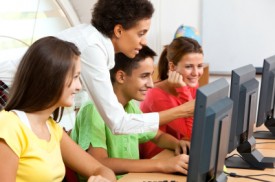
In the blended learning approach, a student’s day typically includes a combination of online learning and small group instruction time with teachers. This learning model shifts the classroom teacher’s focus away from more traditional curricular and administrative tasks in the direction of working with data and providing more individualized support to students. Because the focus in this model has shifted from planning lessons and delivering content to being a facilitator of student learning, the classroom teacher’s role can expand in challenging and stimulating ways.
Rather than follow the traditional roles of sharing content and grading papers, classroom teachers in the blended learning model must:
Be willing to learn
In a blended learning program, the teacher should be prepared to:
- assess, analyze and aggregate data
- use data as an integral part of the planning process for each individual student, groups of students and the whole class
- use benchmark tests and other assessments to direct instruction at different levels (individual, group, class)
To help teachers learn their new roles and to understand online learning, many blended learning programs require that the teachers take an online class themselves as part of the required professional development. Having an experienced blended learning mentor as a guide and participating in training on the data management system also is important. With proper professional development, a “traditional” teacher can develop the data-analysis skills needed to get the most out of the blended learning model.
Be open to new teaching strategies
The blended learning teacher should:
- have a wide breadth of content knowledge in order to teach multiple subjects
- differentiate instruction based upon student needs (as determined by the data)
- focus on academic intervention and enrichment
While blended learning instructors still need to be able to maximize learning time and manage a classroom effectively, they have more individual time with students and can give them the attention and support they need.
Be leaders
To help guide students in a blended learning environment, teachers should:
- model learning and show students how to find information and answers (or ask the right questions)
- be able to manage project-based learning activities
- have strategies in place to keep students on-task, engaged and motivated
The blended learning instructor helps students move beyond simply “regurgitating” rote responses to learning to apply content to new situations. Just as the teacher must interpret and analyze information, students need to learn to reason, integrate information and demonstrate knowledge through application.
So, what might blended learning mean to teachers? Continued growth as they modify their existing strategies to lead students to become independent learners themselves? Technology can also give teachers crucial information to understand individual needs of students to support and strengthen their learning. When teachers use good technology effectively, it provides them the power to become even greater experts in the content areas they teach.
Sir Francis Bacon said, many years ago, "Knowledge is power." So why not gain more power in your classroom by building your expertise in the use of technology?
For further reading:
Technology Moving Teachers from Front to Center of the Classroom
Blended Learning Sports Variety of Approaches:
Related Reading:
Blended Learning Implementation Strategies for the K-12 Classroom
The Trend to Blend: The Debate over Online and Blended Learning

